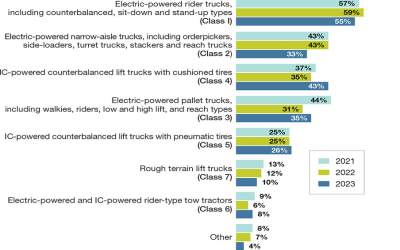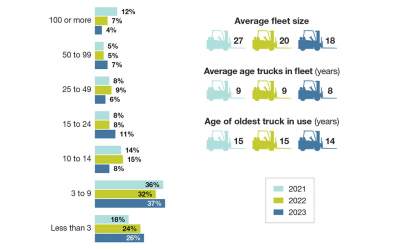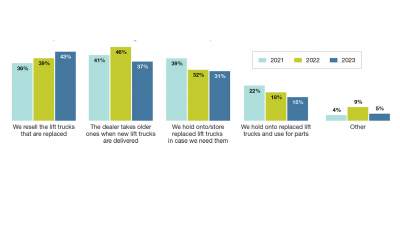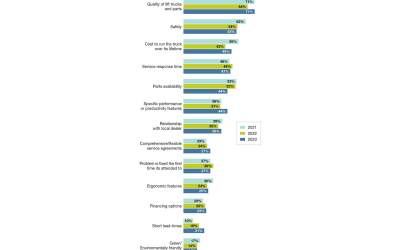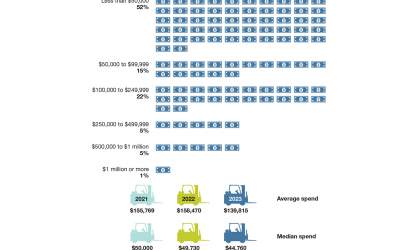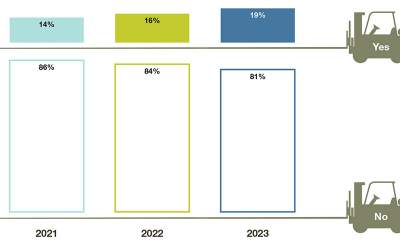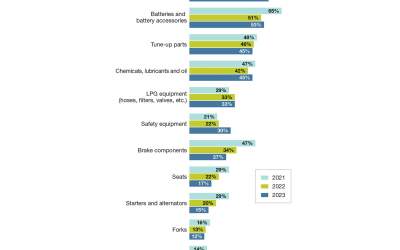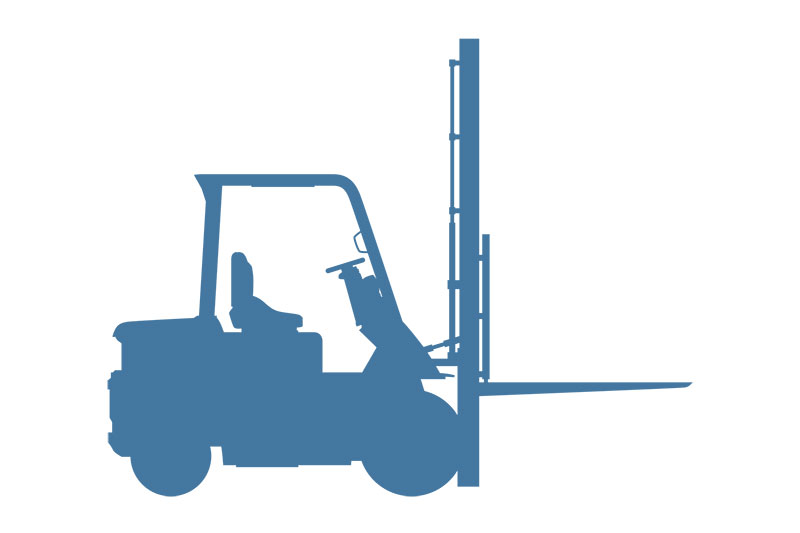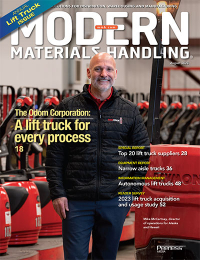What are you driving? The 2023 lift truck acquisition and usage study
Here’s a look at the current lift truck usage and purchasing trends for 2023.
Used to transport heavy goods and materials in warehouses, DCs, factories and job sites, forklifts play an important role in the fulfillment environment. Powered by gas, diesel, propane, battery or electricity, these workhorses of the warehouse are used to load and unload trucks; stack pallets of goods; and move materials around the facility.
Every year, Modern Materials Handling asks readers about the specific lift trucks in use and planned for acquisition; the impact the economy has on lift truck acquisitions; lift truck maintenance arrangements and parts procurement; and use of technology for managing lift truck fleets.
For this year’s “Lift Truck Acquisition and Usage Study,” Peerless Research Group surveyed nearly 200 Modern Materials Handling subscribers through e-mail. With this annual survey, the magazine’s goal is to better understand how lift trucks are acquired and how fleets are managed and maintained.
To qualify for participation in the survey, respondents needed to have a personal involvement in the evaluation and purchase of lift trucks for their facilities. These respondents primarily come from manufacturing (65%), wholesale trade (15%) and the retail trade (5%) industries. The average company size is 255 employees and average revenues are $406 million.
Lift truck fleets at a glance
When asked which types of lift trucks are currently in use in their facilities, more than half of respondents (55%) say they use electric-powered rider trucks, including counterbalanced, sit-down and stand-up types (Class I). This year, 43% of companies are using IC-powered counterbalanced lift trucks with cushioned tires (Class 4), up from 35% in 2022.
More electric-powered pallet trucks, including walkies, riders, low and high lift and reach types (Class 3) are being used this year, with 35% of respondents using them, compared to 31% last year. However, the 2023 numbers are lower than they were in 2021, when 44% of readers reportedly used these vehicles in their facilities.
Electric-powered narrow-aisle trucks, including orderpickers, side-loaders, turret trucks, stackers and reach trucks (Class 2) have decreased in popularity, with 33% of companies using them, compared to 43% in both 2022 and 2021. Additionally, 26% of organizations use IC-powered counterbalanced lift trucks with pneumatic tires (Class 5), while 10% rely on rough terrain lift trucks (Class 7) and 8% use electric-powered and IC-powered rider-type tow tractors (Class 6).
Lift truck fleet sizes differ across organizations, with smaller fleets being the most common among this year’s participants. More than one-third (37%) say they have three to nine lift trucks in their fleet, while 26% say they have less than three.
Meanwhile, 11% have 15 to 24 trucks (up from 8% last year), while 8% have 10 to 14 trucks (down from 15% last year) and 6% have between 25 and 49 trucks. Finally, 7% say they have 50 to 99 trucks and 4% have 100 or more lift trucks in use.
According to the survey, average lift truck fleet sizes are shrinking. Today, the average size is 18 trucks, down from 20 vehicles in 2022 and 27 trucks in 2021. In 2023, the average age of trucks in the fleet was eight years, and the average oldest truck in use was 14 years old.
The characteristics driving decision-making
The most important characteristics companies look for when evaluating lift trucks for purchase or lease are: purchase price (77%); quality of lift trucks and parts (71%); and safety (53%).
Forty-eight percent of respondents consider cost to run the truck over its lifetime to be an important selection factor, 47% say service response time is important, and 44% say parts availability is included in their evaluations. Others say specific performance or productivity features (44%), the relationship with their local dealer (38%), comprehensive or flexible service agreements (27%), and whether a problem is fixed the first time it’s attended to (27%) play a key role in the lift truck selection process.
This year’s survey found that 25% of companies consider ergonomic features when making the decision, while 23% look at financing options, 21% look at short lead time (up from 16% in 2022 and 10% in 2021). Additionally, 14% of respondents consider the lift truck’s environmentally friendly qualities and 13% consider the full breadth of vehicle features when making their decisions.
Truck replacement cycles
Asked how often they typically replace lift trucks, 39% of respondents say 10 years or more (compared to 30% last year); 22% say five to less than eight years; 15% say eight to less than 10 years; and 13% say less than five years. On average, companies say they replace or retire lift trucks every 8.2 years, which is consistent with 2022’s survey findings. Fifty-one percent of companies expect to acquire new lift trucks as a replacement, while 49% expect to acquire new trucks as an addition to their fleet.
When it comes to handling rotation and disposal of lift trucks, 43% resell vehicles no longer being used (up from 39% last year), and 37% say the dealer takes the older trucks back when the new lift trucks are delivered (down from 46% last year). Also, 31% hold onto or store the lift trucks that are replaced just in case they need them and 15% use the out-of-commission vehicles for parts.
Acquisition trends
Forty-three percent of respondents say they operate a core fleet that they use regularly as opposed to a less-utilized reserve fleet. Sixty-six percent of companies buy their new trucks, while 17% say they lease them (up from 11% in 2022), and 18% use a combined approach. In 2023, 48% of lift trucks were purchased and 52% were leased.
Companies are buying more lift trucks this year, with 5.4 trucks being the average target across all respondents. In fact, 61% of respondents say they’re likely to buy or lease lift trucks within the next 12 to 24 months.
When asked how many trucks they plan to acquire during that period, 30% say two to four trucks, 31% say one truck and 23% say five to nine trucks. Also, 3% of companies will purchase 20 trucks or more and 9% plan to acquire 10 to 14 vehicles.
According to the survey, more than half (52%) of respondents will spend less than $50,000 on lift trucks in the upcoming 12 months. However, 15% plan to spend between $50,000 and $99,999; 22% plan to spend $100,000 to $249,999; and 5% plan to spend $500,000 to $1 million. One percent plan to spend $1 million or more, and another 5% plan to spend between $250,000 and $499,999 on lift trucks in the next year. The average expected spend for 2022 is $139,815, down slightly compared to 2022’s average spend expectation of $158,470.
For the most part, companies purchase lift trucks directly from the dealer (88%), but 16% do buy directly from the manufacturer, and 7% purchase their lift trucks from another source.
Economic factors
Roughly 35% of respondents say the economy and current market factors have little to no impact on how they acquire lift trucks, down from a confident 40% last year. Meanwhile, 35% say it does impact their decisions to some extent, and 33% say it impacts them to a great extent (increased from 27% last year).
Over the next 12 months, 71% of companies plan to purchase or replace wheels and tires, 65% plan to purchase or replace batteries or battery accessories, and 48% plan to buy or replace tune-up parts for their lift truck fleet. All of these percentages are higher than they were in 2022. Other companies plan on buying or replacing chemicals, lubricants and oil (47%), brake components (47%), LPG equipment (29%), and seats (29%).
In addition, 21% of respondents plan to buy or upgrade safety equipment, 29% plan to buy or replace starters and alternators, 16% plan to buy new forks, and 14% plan to buy or replace chains to keep up with lift truck maintenance. With the exception of safety equipment, all of these percentages increased compared to 2022’s numbers.
To train their lift truck operators, the majority (74%) of companies have an internal training program within their organization, 18% use dealer training resources (a drop from 22% that used dealer training last year), and 18% use an independent service provider to train their operators (up from 12% in 2022).
For servicing and maintaining lift trucks, 46% say they outsource maintenance to the lift truck dealer, while 27% say it’s handled by in-house staff and 26% say they outsource to a maintenance or service contractor.
Moving forward with technology
Looking to the future, 19% of respondents say they plan on using autonomous or semi-autonomous forklift technology, while 81% say they do not plan to adopt this technology. Over the last three years, a growing number of companies have expressed interest in autonomous or semi-autonomous forklift technology, while the percentage of those saying “no” has been slowly decreasing.
The survey also found that nearly half (48%) of respondents have adopted fleet management software to manage their vehicles. Of those who are using this fleet management technology, 83% say they use it to track maintenance history, 67% use it to track cost to maintain, 75% use it for safety measures, and 52% use it to track truck age.
Those who are using fleet management technology say their implementation has been successful in some capacity. Eighty-two percent say the implementation has been “very” or “somewhat” successful, and 7% say it was extremely successful. Twelve percent consider their fleet management technologies to be either “not very” or “not at all” successful. Aside from a 54% peak in the “somewhat successful” category that happened in 2021, most of these percentages have remained fairly steady for the last three years

Article Topics
Peerless Research Group News & Resources
2024 Intralogistics Robotics Survey: Robot demand surges 2024 Warehouse/DC Outlook Survey: Cautious, but seeking efficiencies We love research The employee satisfaction survey: Don’t worry, be happy MRO Survey: Finding and keeping the best technicians 2024 Automation Study: How automation is transforming the warehousing landscape Top 20 Warehouses 2023: Demand soars and mergers slow More Peerless Research GroupLatest in Materials Handling
Geek+ and System Teknik deploy PopPick solution for pharmacy group Med24.dk Beckhoff USA opens new office in Austin, Texas Manhattan Associates selects TeamViewer as partner for warehouse vision picking ASME Foundation wins grant for technical workforce development The (Not So) Secret Weapons: How Key Cabinets and Asset Management Lockers Are Changing Supply Chain Operations MODEX C-Suite Interview with Harold Vanasse: The perfect blend of automation and sustainability Consultant and industry leader John M. Hill passes on at age 86 More Materials HandlingAbout the Author
Subscribe to Materials Handling Magazine

Find out what the world's most innovative companies are doing to improve productivity in their plants and distribution centers.
Start your FREE subscription today.
April 2024 Modern Materials Handling

Latest Resources


